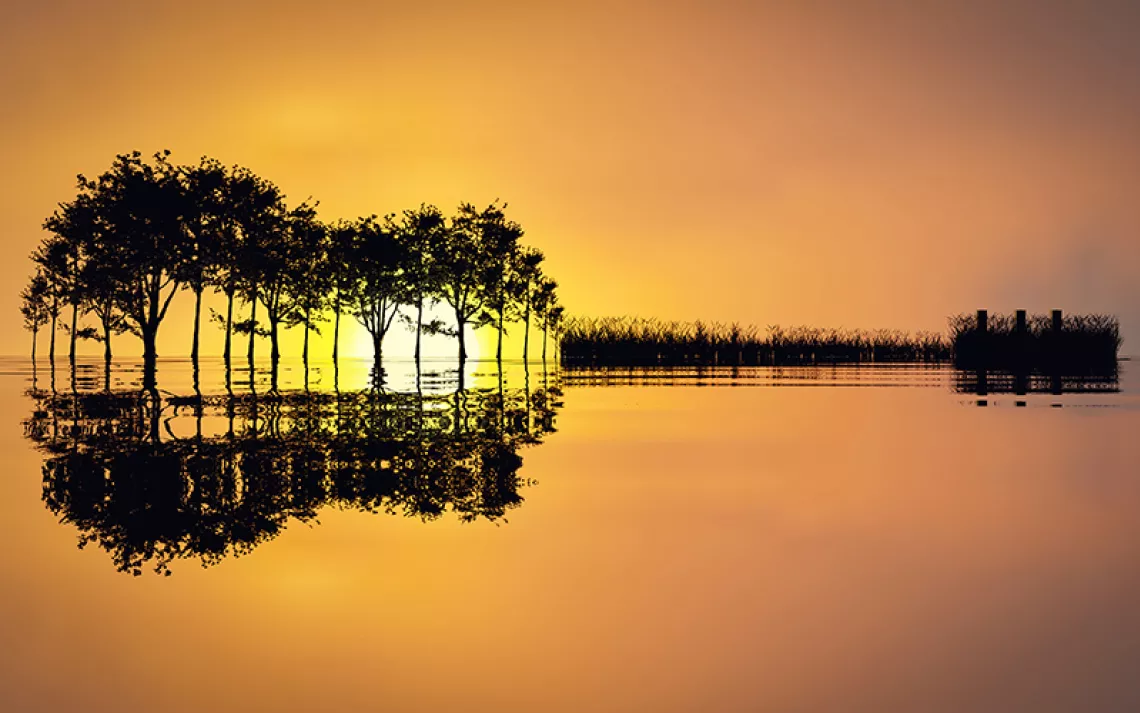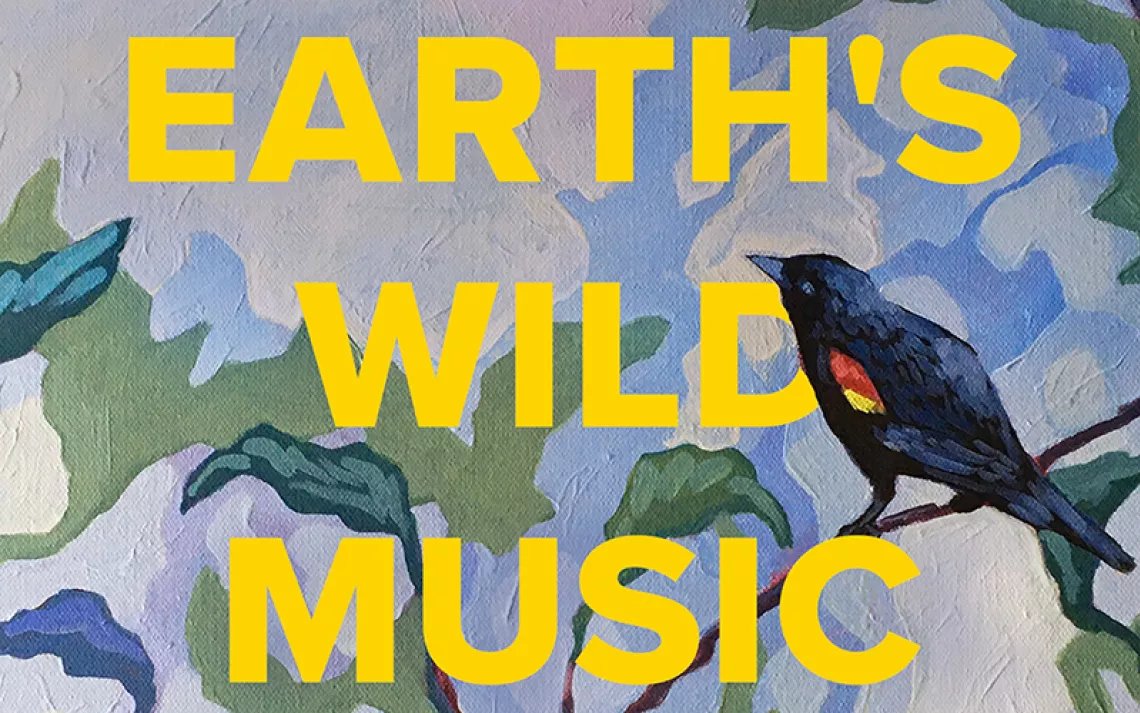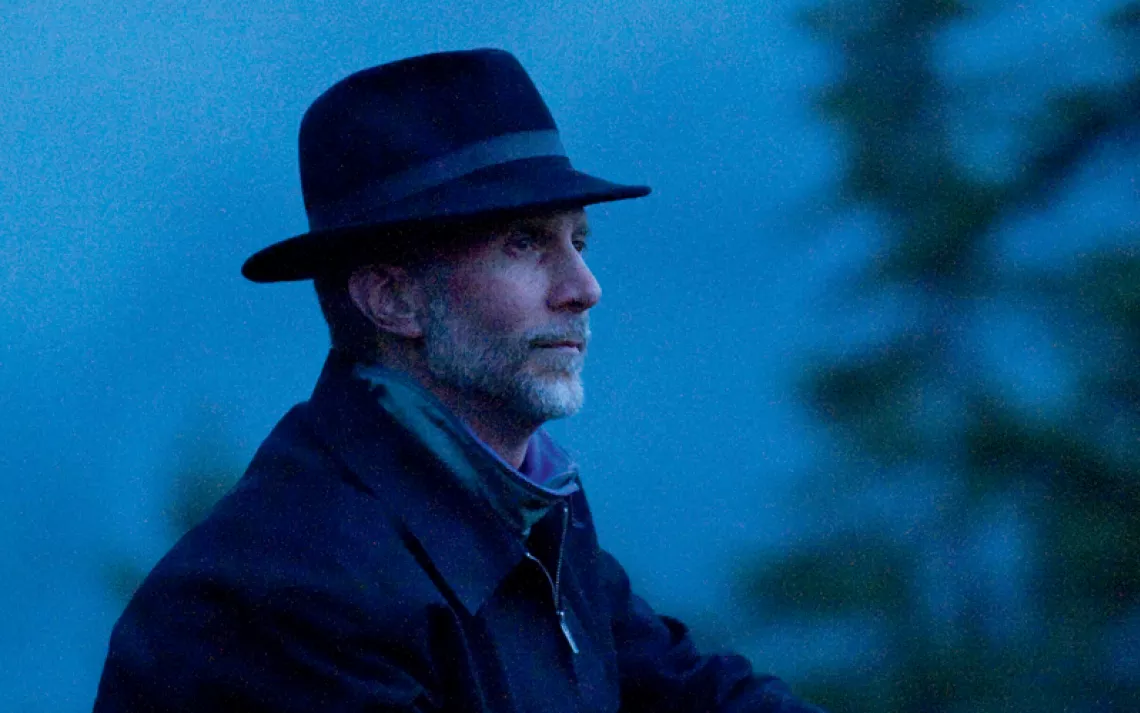Soundscapes on a String
How one artist uses custom-built kites to capture nature’s music
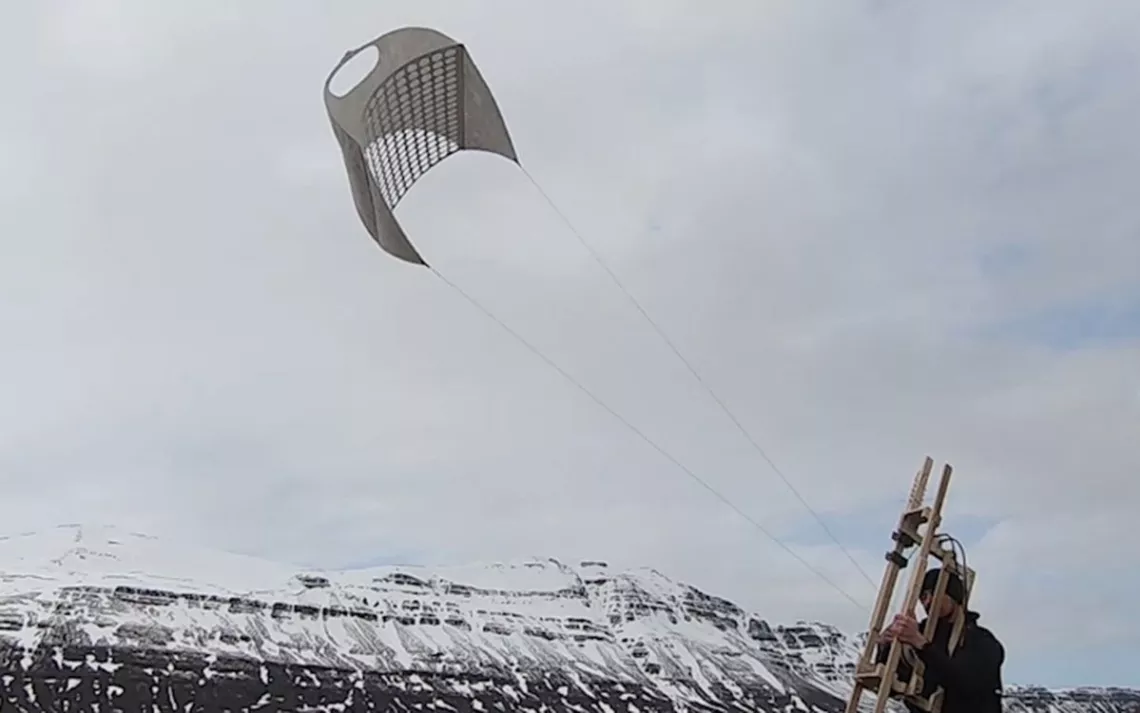
Photos courtesy of Firat Erdim
Standing on the rugged shore of an eastern Iceland fjord, Firat Erdim cranks the reel on a boxy wood-and-string instrument he built by hand. A rosined fishing line extending from the reel connects to a kite fluttering in the breeze. With each slow rotation of the kite’s reel, the rosined line strums guitar strings—which stretch along one edge of the instrument's frame—to generate melodies.
“There are six strings and a kite line that hits those six strings at an angle,” says Erdim, an assistant professor of architecture at Iowa State University. “By turning my body and the instrument in relation to the kite, I can have the line hit one string, or two or three, or all of them.”
Recording equipment, strapped to Erdim’s belt, captures this string music and the surrounding sounds, creating immersive, nature-powered soundtracks that convey a distinct sense of place. The artist's "kite choir" compositions range from melodies that unfold like harp notes set against staccato wind gusts, to haunting, bagpipe-like performances punctuated by birdsong.
By staying attuned to—and involved with—the wind, wildlife, and terrain of a particular moment, Erdim says he’s gained a new appreciation for various environments.
“The wind in Iowa is extremely gusty and textured and full of static compared to wind on a coast, for example. It's a very different atmosphere,” he says. “I'm not a meteorologist, and I don't understand things at that level, but I can sense the difference. It’s like dancing with a different person.”
Erdim started handcrafting these kites after discussing music and instrumentation with his friend, the composer Paula Matthusen. He modifies fishing reels and experiments with poplar boards, polyester ribbons, brass plates, tin cans, and other simple materials. Initial prototypes were acoustic; these days, Erdim sometimes adds magnetic pickups that produce tones evocative of an electric guitar.
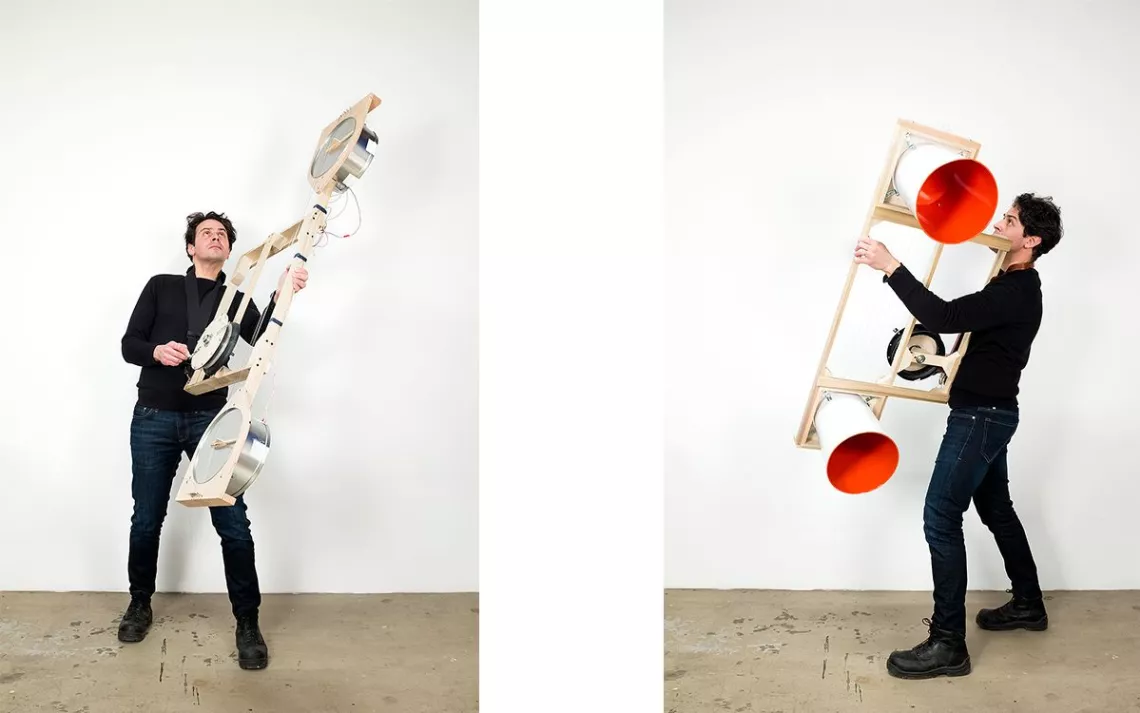
Unlike traditional musical instruments built to generate consistent sound, these creations capitalize on the uncertainty of capricious weather conditions and unpredictable environments.
Erdim compares his creative practice to fishing. He tries to sense, through touch and sound, what is happening at the opposite end of the line.
“It's more about the performance than about making a perfect instrument,” Erdim says. “Even though one gives up a great degree of control with these, compared to conventional musical instruments, there's still a learning curve … it’s about trying to read the topography and the atmosphere, and responding to what seems to happen in the sky.”
Some days, Erdim records delicate, nuanced melodies lilting over light breezes. Different conditions produce intense wails that he likens to “screaming, almost like a kettle coming to a boil.”
Other times, he says, “it can be like a call to prayer from a mosque. It’s a much softer singing, a sort of whistling, that's just fascinating.”
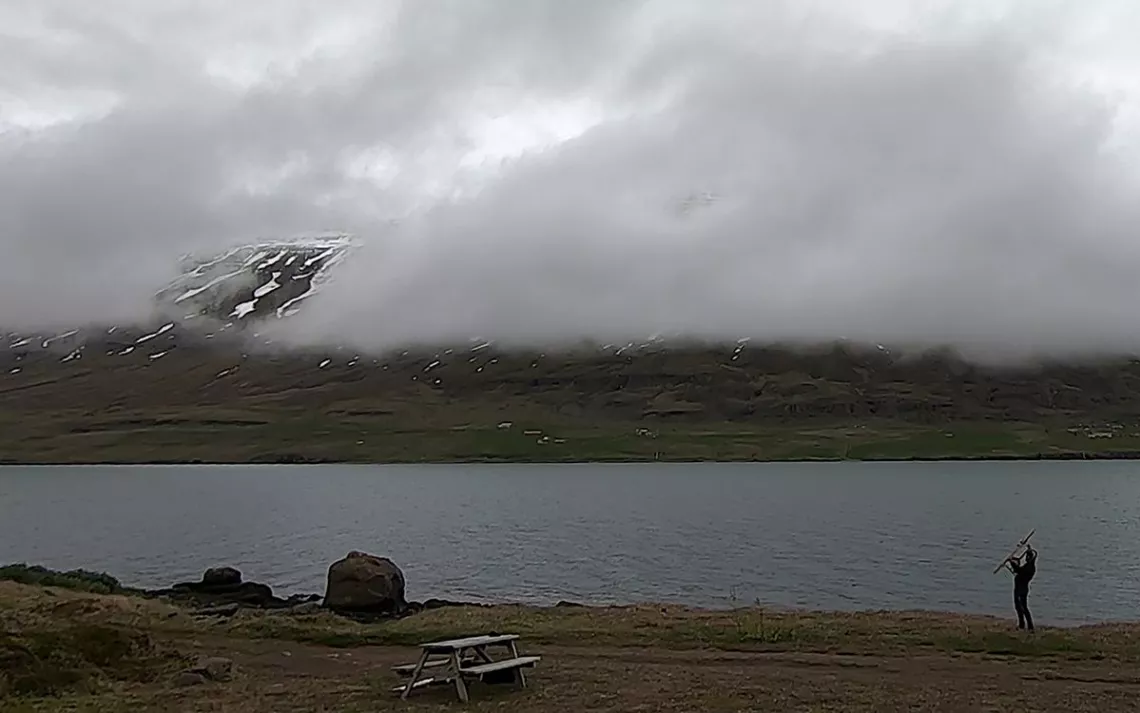
Insects sometimes contribute to performances, as well.
“Iowa in the summer is so noisy—crickets and insects and birds make so much ambient sound. And the crickets, they have that rhythmic chirping thing going on.” Crickets aren’t the only interested creatures, he adds. To help celebrate the 2020 centennial of Iowa's state parks system, Erdim recorded kite music at Lake Macbride State Park. The 2,180-acre playground borders Coralville Lake, a reservoir located between Cedar Rapids and Iowa City.
As he reeled his line back in after one Lake Macbride session, Erdim noticed spiders clustered on the string.
“They were fairly small ones, thank goodness,” he says, with a laugh. “I don't know what kind they were, but they were having a really great time on that line.”
Trading the control traditional musical instruments offer for this collaboration with nature—spiders, crickets, erratic breezes, and all—creates compelling melodies. Still, Erdim believes that tranquil conditions generate the best soundscapes.
“There is this thought that you're supposed to run with a kite, but you really don't have to. If it's the right kite for the wind, and you're in a good place, you should be able to fly it while standing in one spot. It's more about trying to find a stillness, a kind of suspension,” he says. “In the right conditions, the kite can just barely fly and the tow line can actually go a little slack … that's when the most magical stuff happens.”
Location influences each composition, as well.
“The instrument is not just the thing that I'm holding, not just the kite line and the kite. The instrument is really the whole place,” he says.
In 2019, Erdim spent two months recording soundscapes as an artist-in-residence in the coastal village of Seyðisfjörður, Iceland. The region’s rugged, rocky hills, ocean-influenced winds, and tree-free landscape (“Trees eat kites, and they also make the air more turbulent,” he says) offered a strong contrast to the inland openness of central Iowa.
During his Heima Art Residency stay, Erdim selected an instrument, loaded equipment in a backpack, and set out for daily hikes. As he walked, he watched the sky and monitored the movement of the wind. Based on daily conditions, he predicted which side of the fjord might be best for recording, and then chose routes accordingly.
“The thing with Iceland is that the weather changes every five minutes. It can be sunny one moment and there's a blizzard the next,” Erdim says. “But it was really nice, because I was hiking on roads and trails that weren’t really on the way to anywhere. Occasionally, there would be a car, but there were not that many people.”
The solitude connected the artist to the natural world.
“Everything quiets down, and you just listen to the birds and watch what's happening around you. The snow melts into water, feeding hundreds of waterfalls. After a while, daily life falls back, and you really concentrate on what the planet is doing,” he says.
Erdim’s artistic practice tends to net curious glances and questions from hikers who wander into his sessions. In Iceland, one passerby, however, happened to be a sound engineer. The two established an ongoing friendship. Erdim also befriended Poland-born photographer Piotr Kolakowski, after the pair met on a fjord.
"I happened to be having a bad kite day and I wasn't in a good mood, but he took some photographs and we talked briefly about the kite and the conditions," Erdim says. "Now, we're working on a book that will include those photographs that he took, a few sketches from me, and some text written by a poet friend [from New York], Sayward Schoonmaker."
The book’s release date is yet to be finalized, but in the meantime, Erdim shares videos from his kite choir sessions online. He hopes that his work will inspire others to pause and carefully, consciously watch for surprising moments of beauty in nature.
“It's not that different from somebody who goes fishing, in the sense that most people aren't fishing because they are hungry. There's something else about it; there's something about that particular interaction with the world,” Erdim says. “I hope my work can be a sanctuary … maybe it encourages people to create these spaces, these durations of time, for themselves and others.”
 The Magazine of The Sierra Club
The Magazine of The Sierra Club
